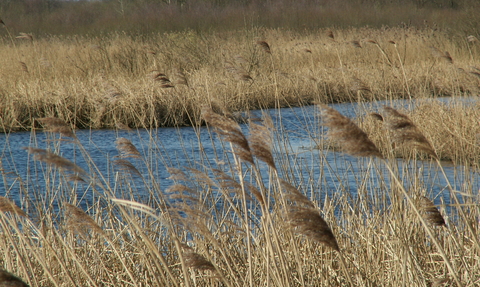
Mark Blake
Westhay Moor Peatland Restoration Project
Amazing Peatlands
Peatlands are an amazing part of our landscapes, not only for the rare and specialised species they support but for the ecosystem services they provide like storing carbon, filtering drinking water, mitigating flood waters etc. Yet 80% of the UK’s peatland are degraded, emitting carbon and threatening the species they support.
Over time agricultural and industrial processes have affected the way peat absorbs and releases water. When peat becomes degraded in this way, its ability to hold water below the surface of the ground is reduced. When healthy, the peat can hold large quantities of water, sucking it up like a sponge, but when it becomes oxidised it does not manage water in the same way.
Photo: Andrew Kirby and Alan Ashman
All the remaining peat at Somerset Wildlife Trust’s Westhay Moor nature reserve has been subject to drainage and peat extraction. This has damaged the hydrology of the peat, meaning that it is drying out and making it more susceptible to drought, wildfire, the encroachment of scrub and trees as well as emitting carbon to the atmosphere.
Over the last two years this restoration project has slowed the flow of water within the peat itself using the deep trench bunding (or cell bunding) technique to seal up sub-surface fissures and cracks which allow the water to move too quickly through our peatland.
Cell bunding involves removing the ‘turf’ on the surface and digging a deep trench. The healthier wet peat that is removed is then put back in the trench and compacted, building a wall within the peatland. The turf is then put back on top of the bund. This process is used to form seals below the surface that allow the peat to retain the water that is needed for the peat to re-wet.
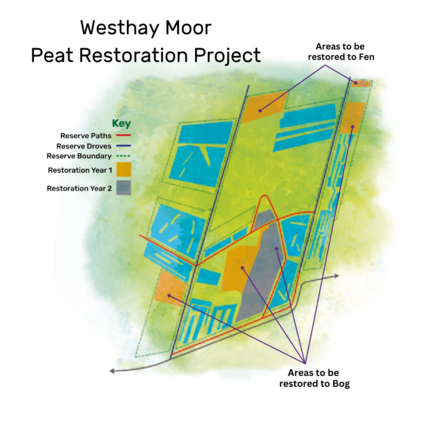
Westhay Moor Restoration Project map. Illustration: Tim Baigent, Glyder Ltd
A number of the specialist peat bog species we wanted to support through this project, and that were already present at the site such as sphagnum mosses, the carnivorous sundew, micro-plume moth, large marsh grasshopper, bog bush cricket and cotton grasses have benefited from these works and in restoring open habitat we have found ground nesting birds like lapwing are at the site more often.
Through the project we have enabled dead standing timber to provide a great habitat for a whole host of invertebrates and also provide feeding corridors for bats. We built a new hibernacula in areas that are intended to stay drier for adders which have migrated onto the site in drier conditions.
Westhay Moor Peat Restoration is a long term project that will take many years of work. Observations at other peat restoration projects suggest that it takes around 3 years for the peat system to recharge hydrologically at which point we hope that the plants and animals that ensure the health of the ecosystem will really begin to thrive.
There were 3 main stages to each area that were earmarked for restoration:
Vegetation Management
Removing the vegetation that was drying out and damaging the peat. The carefully planned removal of some trees as the project evolved has created a habitat more suited to the plant and animal species that would have originally inhabited the peat bog. While it may seem counter intuitive to remove trees it should be remembered that trees would not have been a part of the original peat bog landscape and can only survive as a result of intensive agricultural and industrial drainage. They have a negative effect on the health of the peat by effectively pumping water out of the bog and creating shade in a way that stops target species from growing.
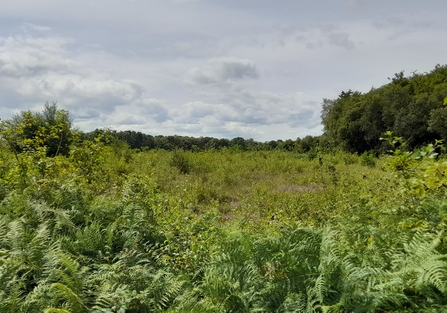
Landscape view of Westhay Moor nature reserve, 2023. Photo: Sian Russell
Hydrological Remediation
Restoring the site’s hydrology to slow the flow of water both inside the peat and on top of it. The peat shrinks and expands which causes cracks and fissures to develop. In some cases, these act like pipes which increase the drainage of water across and away from the peat. This negatively impacts the way in which essential plants that form the peat grow (primarily sphagnum mosses) which in turn further degrades the peat bog.
Re-establishing Peatland Plant Communities
Where needed, we have given the peatland plant communities a helping hand to re-establish a little faster by cultivating and planting new mosses and plants.
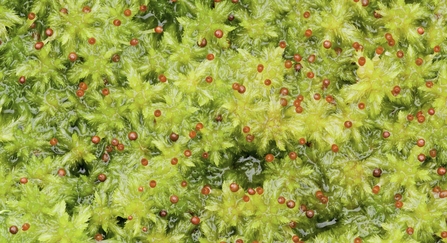
Sphagnum moss with fruiting capsules, Westhay Nature Reserve, Somerset Levels. Image: Ross Hoddinott/2020VISION
We have a network of water level monitoring points across the whole reserve some of which have many years of data associated with them. With help from our volunteers we will continue to monitor these locations for years to come to see whether the works to slow the flow of water and raise the water level year round within the peat have been successful.
The restoration works began in September 2023 and continued until March 2025. Read the FAQ's for more detailed answers to your questions.
Read the latest News and Blogs about peat
Peatland restoration in Somerset reaches major milestone, as innovative project completes on nationally significant nature reserve on the Somerset Levels
Innovative project restores 24 hectares of peat soils, improving peatland hydrology and protecting the carbon stored under the ground.…
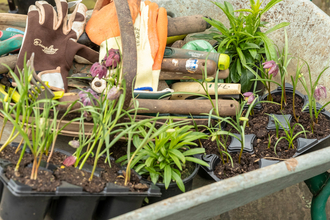
Eight tips for growing without peat
Alice Whitehead from Garden Organic shares advice on using peat-free compost in your garden.
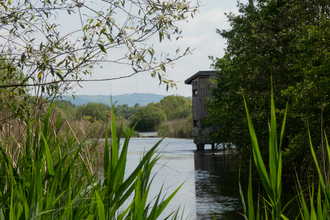
Right Tree, Right Place: Restoring Somerset’s Peatlands
The right tree in the right place can provide many benefits to nature and help in the fight against climate change. However, the wrong…








